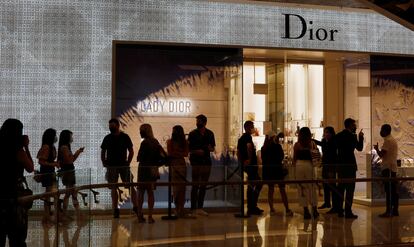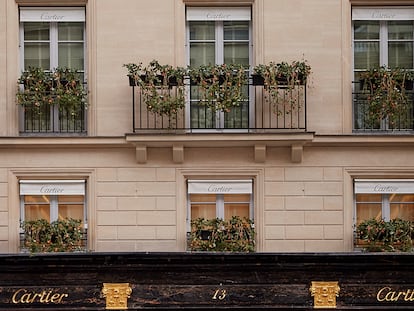Why luxury sales are setting records amid a world in crisis
There are more millionaires from different generations and more millionaires who engage in conspicuous consumption. That means that in these uncertain times, a sector of the population is willing to spend a lot of money on a product just because it is expensive

A classic mid-size 2.55 Chanel bag now costs €9,700, a third more than it did before the pandemic and double its price a decade ago. The French company usually raises the price of its classic items twice a year “because of inflation and currency fluctuations,” its chief financial officer, Philippe Blondiaux, recently said at a press conference. But in 2022, Chanel shattered profit records; its sales rose by at least 17%, exceeding $17 billion, which is 23% more than before the pandemic. As Business of Fashion stated a few days ago, the French fashion house is investing over €500 million to “improve the experience of its top clients” by opening new boutiques on Rodeo Drive (its cruise fashion show was moved to Los Angeles for that reason), finalizing the opening of a new store in London and setting up a hundred private rooms for its premium customers.
This market seems to be applying the concept of targeting big spenders, as luxury marketing refers to them. Brunello Cuccinelli has established a private boutique in New York and Louis Vuitton is completing its VIP lounge at the Qatar airport; in recent months, Dior has opened spas and Bulgari has opened hotels. They are doing so because they can: major luxury brands have all seen their profits grow exponentially in the past year. In 2022, the LVMH conglomerate, owned by Bernard Arnault, the world’s richest man, earned €79.2 billion; a quarter of that (€20 billion) was generated by Louis Vuitton, which just set a new all-time record. For its part, Hermès grew by 23% in 2022 as compared to 2021. “We do not know what will happen in the second half, but for now the market is robust and healthy,” Capri Holdings, the owners of Jimmy Choo, Michael Kors and Versace (which has also raised its prices), said a few weeks ago at a presentation of its business results.
In a world that is bracing for recession, the super-luxury market is thriving. According to the most recent Bain & Co. report, “The luxury market’s consumer base is broadening with some 400 million consumers in 2022 [and is] expected to expand to 500M by 2030… these consumers [are] hungry for unique products and experiences, and putting brands VIC (Very Important Client) strategies into overdrive.” The dynamics of capitalism mean that the concentration of wealth speeds up during a crisis: according to Forbes, in 2021, at the height of the pandemic, there were 5 million more millionaires (i.e., people who have over €1 million), and estimates say that the super rich, i.e., 1% of the population, already possess approximately 40% of the wealth.
Surprisingly, according to a Bain & Co. and Altagamma report, over the past year, the purchase of products—not the enjoyment of premium experiences—has increased by over 20%; people are buying five and even six figure handbags, watches, cars, etc. That makes sense: over the past two years, both companies and consulting firms have sold the idea of buying certain models as an investment that appreciates in value every few years. The latest report by Deloitte and Credit Suisse on products that resist uncertainty and inflation cited handbags, jewelry and watches as objects that increase in value by between 4.5 and 6.5 percent per year. The report listed Chanel as one of the “safest” brands. “If you’re going to buy a luxury handbag, Chanel is one of the few brands most likely to increase in value after leaving the store,” an article at Sotheby’s auction house explained.
The idea of investing in a handbag as if it were investing in bricks is not new. Almost a decade ago, news stories claiming that a Hermès Birkin bag was as safe as gold went viral. In fact, in recent months, many financial media outlets have argued that the French fashion house’s increased prices reflect a desire to resemble Hermès in the collective imagination with objects as expensive as they are exclusive, desirable, and “safe.”
In the spring of 2020, after being closed for two months, a Hermès store in Guangzhou, China, brought in sales of €2.5 million in a single day. Then people began to talk about revenge shopping or “revenge buying” (a sociological term coined in the 1980s, when China began to consume rampantly after the fall of communism). The idea is rooted in the spirit of carpe diem during uncertain or difficult times. With travel restricted in Asia, an important luxury market, companies began to reinforce their presence in the region; now, three years later, they have decided to open private and by-appointment-only stores for the super-rich seeking to buy classic items. The companies have realized that, in the minds of these consumers, whimsy is read as an investment. A similar phenomenon is happening with fine jewelry: for example, Cartier has earned €10 billion a year, while Bulgari is opening another large store in Italy. “Optimism among the most luxurious jewelry brands has never been higher,” the New York Times recently wrote.
None of this is new, but it is slightly different. Luxury doesn’t fluctuate at times of crisis, but experts believe there will be more consumption now than there was during the 2008 crisis. “This time there is not as much concern about conspicuous consumption,” The Financial Times explains. “After the global financial crisis, governments bailed out companies; after the pandemic, Americans alone spent $2 trillion on a ‘stimulus’ in one year… This likely recession affects the lower and middle classes; it’s different.” Today, there are more millionaires, more millionaires from diverse generations, and more millionaires willing to embrace the idea of conspicuous consumption, the concept coined by sociologist Thorstein Veblen in 1899. In other words, during times of uncertainty, a sector of the population is willing to spend a lot of money on a product simply because the item is expensive.
Sign up for our weekly newsletter to get more English-language news coverage from EL PAÍS USA Edition
Tu suscripción se está usando en otro dispositivo
¿Quieres añadir otro usuario a tu suscripción?
Si continúas leyendo en este dispositivo, no se podrá leer en el otro.
FlechaTu suscripción se está usando en otro dispositivo y solo puedes acceder a EL PAÍS desde un dispositivo a la vez.
Si quieres compartir tu cuenta, cambia tu suscripción a la modalidad Premium, así podrás añadir otro usuario. Cada uno accederá con su propia cuenta de email, lo que os permitirá personalizar vuestra experiencia en EL PAÍS.
¿Tienes una suscripción de empresa? Accede aquí para contratar más cuentas.
En el caso de no saber quién está usando tu cuenta, te recomendamos cambiar tu contraseña aquí.
Si decides continuar compartiendo tu cuenta, este mensaje se mostrará en tu dispositivo y en el de la otra persona que está usando tu cuenta de forma indefinida, afectando a tu experiencia de lectura. Puedes consultar aquí los términos y condiciones de la suscripción digital.
More information
Archived In
Últimas noticias
Venezuela hardens its ‘revolutionary state’ project amid pressure from Trump
Sydney Sweeney, the actress praised by Trump: ‘Women are up against what society wants them to be’
The Bolsonaro surname: An advantage or liability in Brazil’s 2026 presidential elections?
Raúl Rocha, from jet-setting with Miss Universe to arms trafficking and fuel theft
Most viewed
- Reinhard Genzel, Nobel laureate in physics: ‘One-minute videos will never give you the truth’
- Pablo Escobar’s hippos: A serious environmental problem, 40 years on
- Charles Dubouloz, mountaineering star, retires at 36 with a farewell tour inspired by Walter Bonatti
- Why we lost the habit of sleeping in two segments and how that changed our sense of time
- The fall of a prolific science journal exposes the billion-dollar profits of scientific publishing











































